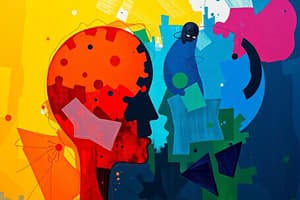Podcast
Questions and Answers
What is dispositional attribution?
What is dispositional attribution?
Attributing behavior to the person's personality rather than situational factors.
What is situational attribution?
What is situational attribution?
Attributing behaviors to factors external to an actor, such as the task, other people, or luck.
What is explanatory style?
What is explanatory style?
One's habitual way of explaining life events.
What is optimistic explanatory style?
What is optimistic explanatory style?
What is actor/observer bias?
What is actor/observer bias?
What is the fundamental attribution error?
What is the fundamental attribution error?
What is self-serving bias?
What is self-serving bias?
What is internal locus of control?
What is internal locus of control?
What is the mere exposure effect?
What is the mere exposure effect?
What is a self-fulfilling prophecy?
What is a self-fulfilling prophecy?
What is upward social comparison?
What is upward social comparison?
What is relative deprivation?
What is relative deprivation?
What is a stereotype?
What is a stereotype?
What is cognitive load?
What is cognitive load?
What is prejudice?
What is prejudice?
What is discrimination?
What is discrimination?
What are implicit attitudes?
What are implicit attitudes?
What is the just-world phenomenon?
What is the just-world phenomenon?
What is out-group homogeneity effect?
What is out-group homogeneity effect?
What is in-group bias?
What is in-group bias?
What is ethnocentrism?
What is ethnocentrism?
What is belief perseverance?
What is belief perseverance?
What is confirmation bias?
What is confirmation bias?
What is cognitive dissonance?
What is cognitive dissonance?
What are social norms?
What are social norms?
What is social influence theory?
What is social influence theory?
What is normative social influence?
What is normative social influence?
What is informational social influence?
What is informational social influence?
What is persuasion?
What is persuasion?
What is groupthink?
What is groupthink?
What is diffusion of responsibility?
What is diffusion of responsibility?
What is social loafing?
What is social loafing?
What is deindividuation?
What is deindividuation?
What is social facilitation?
What is social facilitation?
What is false consensus effect?
What is false consensus effect?
What are superordinate goals?
What are superordinate goals?
What is the elaboration likelihood model?
What is the elaboration likelihood model?
What is central route persuasion?
What is central route persuasion?
What is peripheral route persuasion?
What is peripheral route persuasion?
What is the halo effect?
What is the halo effect?
What is the foot-in-the-door technique?
What is the foot-in-the-door technique?
What is the door-in-the-face technique?
What is the door-in-the-face technique?
What is a social trap?
What is a social trap?
What is Industrial-Organizational Psychology?
What is Industrial-Organizational Psychology?
What is burnout?
What is burnout?
What is altruism?
What is altruism?
What is prosocial behavior?
What is prosocial behavior?
Flashcards
Dispositional Attribution
Dispositional Attribution
Attributing behavior to a person's character, not the situation.
Situational Attribution
Situational Attribution
Attributing behavior to external factors, like task or luck.
Explanatory Style
Explanatory Style
Habitual way of explaining life events.
Optimistic Explanatory Style
Optimistic Explanatory Style
Signup and view all the flashcards
Pessimistic Explanatory Style
Pessimistic Explanatory Style
Signup and view all the flashcards
Actor/Observer Bias
Actor/Observer Bias
Signup and view all the flashcards
Fundamental Attribution Error
Fundamental Attribution Error
Signup and view all the flashcards
Self-Serving Bias
Self-Serving Bias
Signup and view all the flashcards
Internal Locus of Control
Internal Locus of Control
Signup and view all the flashcards
External Locus of Control
External Locus of Control
Signup and view all the flashcards
Mere Exposure Effect
Mere Exposure Effect
Signup and view all the flashcards
Self-Fulfilling Prophecy
Self-Fulfilling Prophecy
Signup and view all the flashcards
Upward Social Comparison
Upward Social Comparison
Signup and view all the flashcards
Downward Social Comparison
Downward Social Comparison
Signup and view all the flashcards
Relative Deprivation
Relative Deprivation
Signup and view all the flashcards
Stereotype
Stereotype
Signup and view all the flashcards
Cognitive Load
Cognitive Load
Signup and view all the flashcards
Prejudice
Prejudice
Signup and view all the flashcards
Discrimination
Discrimination
Signup and view all the flashcards
Implicit Attitudes
Implicit Attitudes
Signup and view all the flashcards
Just-World Phenomenon
Just-World Phenomenon
Signup and view all the flashcards
Out-Group Homogeneity Effect
Out-Group Homogeneity Effect
Signup and view all the flashcards
In-Group Bias
In-Group Bias
Signup and view all the flashcards
Ethnocentrism
Ethnocentrism
Signup and view all the flashcards
Belief Perseverance
Belief Perseverance
Signup and view all the flashcards
Confirmation Bias
Confirmation Bias
Signup and view all the flashcards
Cognitive Dissonance
Cognitive Dissonance
Signup and view all the flashcards
Social Norms
Social Norms
Signup and view all the flashcards
Normative Social Influence
Normative Social Influence
Signup and view all the flashcards
Informational Social Influence
Informational Social Influence
Signup and view all the flashcards
Study Notes
- This flashcard set covers social psychology, personality, and related concepts.
Attribution
- Dispositional Attribution: Behavior is attributed to a person’s personality.
- Situational Attribution: Behavior is attributed to external factors such as luck or other people.
- Explanatory Style: Habitual way of explaining life events.
- Optimistic Explanatory Style: Explaining unfavorable events as unstable, temporary, and controllable
- Pessimistic Explanatory Style: Interpreting negative events as internally based and a constant, stable quality.
- Actor/Observer Bias: The tendency to attribute one's own actions to the situation and others' actions to their personalities.
- Fundamental Attribution Error: Underestimating the impact of the situation and overestimating the impact of personal disposition when analyzing others' behavior.
- Self-Serving Bias: The tendency to perceive oneself favorably.
Locus of Control
- Internal Locus of Control: The perception that you control your own fate.
- External Locus of Control: The perception that chance or outside forces determine your fate.
Social Cognition
- Mere Exposure Effect: Repeated exposure to novel stimuli increases liking of them.
- Self-Fulfilling Prophecy: An expectation that causes you to act in ways that make that expectation come true.
- Upward Social Comparison: Comparing ourselves to people who are better than we are.
- Downward Social Comparison: Comparing ourselves to people who are worse than we are.
- Relative Deprivation: The perception that one is worse off than those they compare themselves to.
Stereotypes, Prejudice, and Discrimination
- Stereotype: A generalized belief about a group of people.
- Cognitive Load: The amount of mental resources needed to carry out a task.
- Prejudice: An unjustifiable (usually negative) attitude toward a group and its members.
- Discrimination: Unjustifiable negative behavior toward a group and its members.
- Implicit Attitudes: Attitudes that influence feelings and behavior at an unconscious level.
- Just-World Phenomenon: The belief that the world is just and people get what they deserve.
- Out-group Homogeneity Effect: The tendency to see members of out-groups as very similar to one another.
- In-Group Bias: The tendency to favor individuals within our group over those from outside our group.
- Ethnocentrism: Belief in the superiority of one's ethnic group.
Beliefs and Biases
- Belief Perseverance: Clinging to one's initial conceptions after they have been discredited.
- Confirmation Bias: Seeking information that supports preconceptions and ignoring contradictory evidence.
- Cognitive Dissonance: Unpleasant state when a person recognizes inconsistency in their actions, attitudes, or beliefs.
- Social norms: Expectations regarding what is appropriate and acceptable for members' attitudes and behaviors.
Social Influence and Persuasion
- Social Influence Theory: People do and report what is expected of them.
- Normative Social Influence: Influence from a desire to gain approval or avoid disapproval.
- Informational Social Influence: Influence from taking others' comments or actions as correct, proper, or effective.
- Persuasion: The process of creating, reinforcing, or changing people's beliefs or actions.
Group Dynamics
- Groupthink: Desire for harmony in a decision-making group overrides realistic appraisal of alternatives.
- Diffusion of Responsibility: Reduction in feelings of personal responsibility in the presence of others.
- Social Loafing: People exert less effort in a group when pooling efforts toward a common goal.
- Deindividuation: Loss of self-awareness and self-restraint in group situations that foster arousal and anonymity.
- Social Facilitation: Improved performance on simple or well-learned tasks in the presence of others.
- False Consensus Effect: Overestimating the extent to which others share our beliefs and behaviors.
- Superordinate Goals: Shared goals that override differences and require cooperation.
- Group Polarization: The shift of group members to an extreme position after discussing an issue as a group.
Persuasion Models and Techniques
- Elaboration Likelihood Model: Theory of how persuasive messages lead to attitude changes.
- Central Route Persuasion: Attitude change through focus on arguments and facts.
- Peripheral Route Persuasion: Attitude change influenced by incidental cues, like a speaker's attractiveness.
- Halo Effect: Tendency to draw a general impression based on a single characteristic.
- Foot-in-the-Door Technique: Making a small request before incrementally increasing later requests.
- Door-in-the-Face Technique: Making an unreasonably large request before making a smaller, hoped-for request.
Social Issues
- Social Trap: Conflicting parties, pursuing self-interest, become caught in mutually destructive behavior.
Workplace Psychology
- Industrial-Organizational Psychology: Application of psychological concepts to optimize human behavior in workplaces.
- Burnout: Physical, emotional, and mental exhaustion from long-term involvement in emotionally demanding situations.
Altruism and Social Norms
- Altruism: Unselfish regard for the welfare of others.
- Prosocial Behavior: Positive, constructive, helpful behavior.
- Social Debt: Guilt from negative social interactions.
- Social Reciprocity Norm: An expectation that people will help those who have helped them.
- Social Responsibility Norm: An expectation that people will help those dependent upon them.
Conformity and Obedience
- Conformity: Adjusting behavior or thinking to coincide with a group standard.
- Obedience: Changing behavior at the command of an authority figure.
Cultural Psychology
- Individualism: Prioritizing one's own goals over group goals.
- Collectivism: Prioritizing the goals of one's group.
- Multiculturalism: Valuing and respecting differences in culture.
Bystander Effect and Situational Variables
- Bystander Effect: A person is less likely to provide help when others are nearby.
- Situational Variables: Environment features affecting the degree to which individuals yield to group pressures.
- Attentional variables: A factor that influences focused attention.
Psychodynamic Theory
- Psychodynamic Theory: Emphasizes internal conflicts, motives, unconscious forces and their influence on behavior.
- Unconscious Processes: Mental processes that are not available to conscious awareness.
- Ego Defense Mechanisms: Unconscious distortions of thoughts or perceptions that reduce anxiety.
- Denial: Refusing to believe or perceive painful realities.
- Displacement: Redirecting aggressive impulses onto a less dangerous target.
- Projection: Attributing one's own threatening impulses to others.
- Rationalization: Offering self-justifying explanations for one's actions.
- Reaction Formation: Behaving in a way opposite to true feelings.
- Regression: Retreating to a more infantile psychosexual stage.
- Repression: Forcing anxiety-provoking thoughts and feelings into the unconscious.
- Sublimation: Directing unacceptable energies into socially admirable outlets.
- Projective Test: Personality test using ambiguous stimuli to trigger projection of inner dynamics.
- Preconscious Mind: Contains inactive but potentially accessible thoughts and memories.
- Unconscious Mind: Where thoughts, feelings, and memories are kept that are not easily brought into consciousness.
Humanistic Psychology
- Humanistic Psychology: Emphasizes the positive potential of human beings.
- Unconditional Regard: Total acceptance toward another person.
- Self-Actualizing Tendency: The striving to fulfill one's innate capacities and capabilities.
Social-Cognitive Theory and Self-Concept
- Social Cognitive Theory: Use of cognitive processes in relation to understanding the social world.
- Reciprocal Determinism: Interacting influences between personality and environmental factors.
- Self-Concept: All thoughts and feelings about ourselves.
- Self-Efficacy: Belief in one's capability to perform a task.
- Self-Esteem: How much you value, respect, and feel confident about yourself.
Trait Theories and Personality Dimensions
- Trait Theories: Describe characteristics that make up human personality to predict future behavior.
- Big Five Theory: Identifies five main personality characteristics:
- Agreeableness: Good-natured, cooperative, and trusting.
- Openness to Experience: Imagination, sensitivity, and curiosity.
- Extraversion: Sociable, gregarious, and assertive.
- Conscientiousness: Responsible, dependable, persistent, and organized.
- Emotional Stability: Feeling secure and unworried
- Personality Inventories: Questionnaires assessing a range of feelings and behaviors to assess traits.
- Factor Analysis: Statistical technique explaining correlations in terms of underlying factors.
Motivation Theories
- Drive Reduction Theory: Motivation arises from imbalances in homeostasis.
- Homeostasis: Maintaining a balanced internal state.
- Arousal Theory: People are motivated to maintain an optimal level of alertness.
- Optimal Level of Arousal: The human need for a comfortable level of stimulation.
- Yerkes-Dodson Law: Performance increases with arousal only up to a point.
- Self-Determination Theory: Concerned with the beneficial effects of intrinsic motivation and the harmful effects of extrinsic motivation.
- Intrinsic Motivation: Performing a behavior for its own sake.
Studying That Suits You
Use AI to generate personalized quizzes and flashcards to suit your learning preferences.




